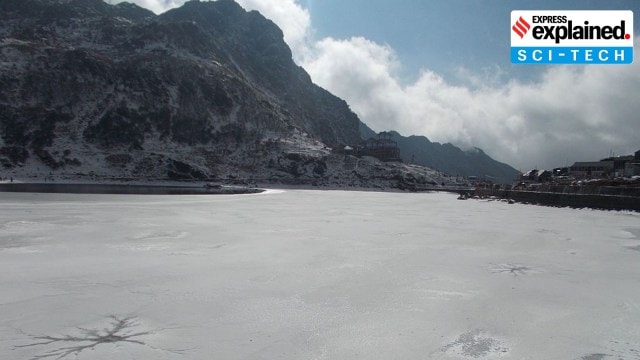- India
- International
How ISRO used satellite remote-sensing to analyse glacial lakes in Himalayas
This is the latest among a clutch of studies on glacial lakes that have highlighted the risks of glacial lake outburst floods (GLOFs), and their impact on infrastructure and settlements downstream of such lakes.
 ISRO said that 130 of the 676 lakes are situated in India, in the Indus (65), Ganga (7), and Brahmaputra (58) river basins. These lakes have expanded as glaciers are retreating at an ever faster rate due to global warming.
(Wikimedia Common)
ISRO said that 130 of the 676 lakes are situated in India, in the Indus (65), Ganga (7), and Brahmaputra (58) river basins. These lakes have expanded as glaciers are retreating at an ever faster rate due to global warming.
(Wikimedia Common)Earlier this week, the Indian Space Research Organisation (ISRO) released satellite-data-based analysis on expansion of glacial lakes in the catchments of Indian Himalayan river basins. This is the latest among a clutch of studies on glacial lakes that have highlighted the risks of glacial lake outburst floods (GLOFs), and their impact on infrastructure and settlements downstream of such lakes.
What did ISRO’s analysis reveal?
ISRO’s analysis looked at satellite data archives spanning the past four decades to assess changes in the glaciated environment. Long-term satellite imagery covering the catchments of Indian Himalayan river basins — spread over India, Nepal, Tibet, and Bhutan — is available from 1984 onwards, till 2023. ISRO’s data has indicated significant expansion in the size of glacial lakes.
Of the 2,431 lakes larger than 10 hectares (identified during 2016-17), 676 glacial lakes had expanded significantly since 1984. Of these 676 lakes, 601 lakes had more than doubled in size, 10 lakes had grown between 1.5 to 2 times, and 65 lakes had grown 1.5 times.
ISRO said that 130 of the 676 lakes are situated in India, in the Indus (65), Ganga (7), and Brahmaputra (58) river basins. These lakes have expanded as glaciers are retreating at an ever faster rate due to global warming.
How are glacial lakes formed?
The movement of glaciers causes erosion and creates depressions in the surrounding topography. When they retreat, meltwater starts to accumulate in such depressions, giving birth to glacier lakes.

ISRO categorised glacial lakes into four broad categories based on how they were formed — moraine-dammed, ice-dammed, erosion-based, and ‘others’. Moraine and ice-dammed lakes are formed when water is dammed by moraine — debris such as rocks and soil left during the movement of glaciers — and ice respectively. Erosion-based lakes are formed when water is dammed by erosion-created depressions.
While glacial lakes are crucial sources of freshwater for rivers, they also pose significant risks, specifically of GLOFs, which can have devastating consequences on communities downstream.
“GLOFs occur when glacial lakes release large volumes of meltwater due to the failure of natural dams… resulting in sudden and severe flooding downstream. These dam failures can be triggered by various factors, including avalanches of ice or rock,” ISRO said.
How is satellite remote-sensing technology used to monitor glacial lakes?
The monitoring of glacial lakes and their expansion in the Himalayan region is challenging due to the rugged terrain. This is where, according to ISRO, satellite remote-sensing technology “proves to be an excellent tool for… monitoring due its wide coverage and revisit capability”.
“Satellite-derived long-term change analysis provide valuable insights for understanding glacial lake dynamics, which are essential for assessing environmental impacts and developing strategies for GLOM risk management and climate change adaptation in glacial environments,” ISRO said.
Glaciologist Ashim Sattar, Assistant Professor, Indian Institute of Technology, Bhubaneswar, said: “Most of the glacial lake sites are not accessible by motorable roads. In this scenario, remote sensing tools, which are highly advanced now, can help us monitor the growth of glacial lakes and understand their dynamics”.
He also said fieldwork can be carried out at lake sites which have been identified as potentially critical. “Fieldwork is crucial to set up instrumentation for early warning systems. These can include installing motion detection cameras, water level sensors, discharge meters etc. that can capture anomalous activity in and around glacial lakes,” Sattar said.
How can the risks posed by glacial lakes be mitigated?
In 2023, a study published in the Journal of Geophysical Research examined the risks posed by Ghepan Gath lake — located at an elevation of 4,068 m in Himachal Pradesh — to Sissu in Lahaul valley, and modelled the impacts of lowering the water levels in the lake.
It found that lowering of the lake levels by 10 to 30 m significantly reduces the impacts on Sissu town, though not completely eliminating the risks posed by a GLOM event.
One way to syphon off lake water is by using long High Density Polyethylene (HDPE) pipes. In 2016, members of the Sikkim State Disaster Management Authority and Sikkim’s Department of Science and Technology and Climate Change, among others, used this method to reduce water levels in Sikkim’s South Lhonak Lake.
More Explained
EXPRESS OPINION
May 11: Latest News
- 01
- 02
- 03
- 04
- 05































